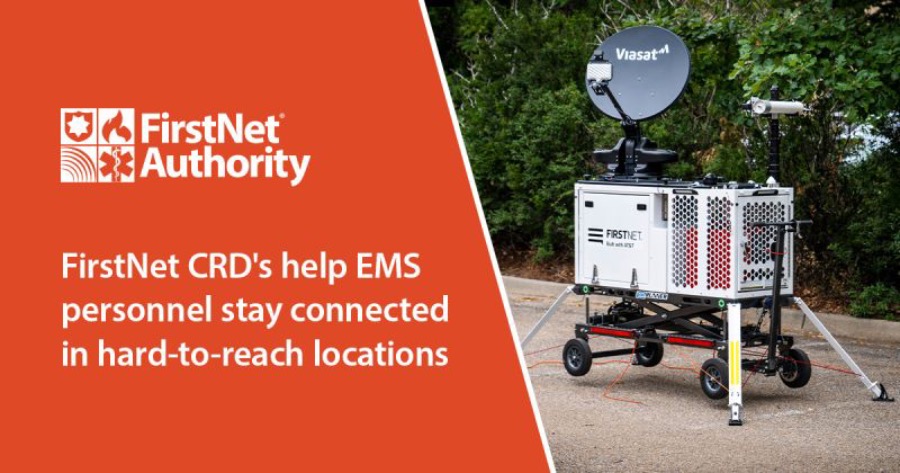
EMTs and paramedics can be called to duty in incredibly hard-to-reach locations, and they need connectivity where their mission takes them. Compact Rapid Deployables are a unique FirstNet coverage solution that keeps responders connected even in the toughest spots.
We have heard from the public safety community that they need connectivity when and where every incident occurs.
Compact Rapid Deployables (CRDs) are one option to deliver that function. CRDs are mobile cell sites that provide FirstNet connectivity via satellite, don’t require commercial power, and are much smaller than traditional deployables. They offer distinct benefits:
Transportability. The units are small enough to fit through most doorways and elevators. They can be transported using a regular trailer hitch or flown into a remote location by helicopter.
Durability. CRDs are built to withstand the elements: they’re weatherproof and operate in temperatures from -22° to 122°F. They can last up to 60 hours before needing to be refueled.
Connectivity. The range for FirstNet cellular coverage is up to two miles. The CRD provides high-speed internet via Wi-Fi or Ethernet cable. A public safety agency can decide whether to allow non-FirstNet users to connect to Wi-Fi within 500 feet. The units can support 64 simultaneous FirstNet calls and over 100 text or data users.
Ease of use. Individual agencies can purchase their own CRD and deploy it at their own discretion. The units can be activated by a single person within a matter of minutes.
Because of their versatility, CRDs ensure FirstNet coverage virtually anytime and anywhere.
When Hurricane Ian struck Florida in late September, the category 4 storm was one of the worst in the state’s long history with hurricanes.
The storm ravaged infrastructure in southwest Florida, including the causeway connecting Sanibel Island and the mainland, making boats the only way to reach the island. First responders needed to restore connectivity as soon as possible. Bigger deployables like a Satellite Cell on Light Truck (SatCOLT) were too heavy to be transported using the vessels available. Instead, the AT&T FirstNet team took a lighter, smaller CRD across the water using an amphibious vehicle from its disaster recovery fleet. The CRD re-established connectivity for first responders on the island.
Farther north in Florida, response teams on Pine Island faced the same issues. The bridge connecting the island to the mainland was demolished by Hurricane Ian, and first responders on scene needed to communicate. The AT&T FirstNet team loaded a CRD onto a helicopter and flew it to the island. Within minutes of landing, connectivity was restored for first responders.
The CRDs sent to Sanibel and Pine Islands are part of the FirstNet deployables fleet. The 150+ assets in the fleet are stationed around the country, so they can be deployed to incidents within 14 hours. Once Hurricane Ian was projected to hit land, the AT&T FirstNet team positioned extra deployables throughout the southeast in preparation for the storm.
When disasters and emergencies occur, public safety agencies can request a deployable multiple ways. The easiest is to use the online Deployable Request Tool in FirstNet Central—which pre-fills your account information and takes about 5 to 10 minutes to complete—or call 1-800-574-7000 and specifically state, “I need to request a deployable asset.” The FirstNet Authority’s Emergency Management Guide has detailed information about using deployables in an emergency.
Agencies can also choose to purchase their own CRDs. While an investment, an in-house CRD gives an agency complete control of its connectivity. An agency can decide when to deploy its own CRD in disasters, major events, or for remote operations like search and rescue missions.
Learning about Sanibel and Pine Islands, I was reminded of my own challenges with connectivity during a disaster. In 2019, the catastrophic Hurricane Dorian hit my home state of North Carolina. It was especially damaging to Ocracoke Island. I led an ambulance strike team that deployed to the island.
During the two-hour ferry ride to the island, we wondered if we would have communications capabilities when we got there. I was an early FirstNet subscriber as were several other members of the strike team. When we got to the island, a FirstNet SatCOLT was operational, allowing us to communicate as we responded to the havoc wreaked by the storm.
If we had a CRD on that mission, we wouldn’t have had to wonder about connectivity. The CRD ensures you can communicate wherever you go. That’s what makes it a great tool to take on deployments. It establishes coverage around your base of operations to share data among teams, to connect to the emergency operations center, and to allow responders to check in with family back home. CRDs deliver connectivity when and where it’s needed most.